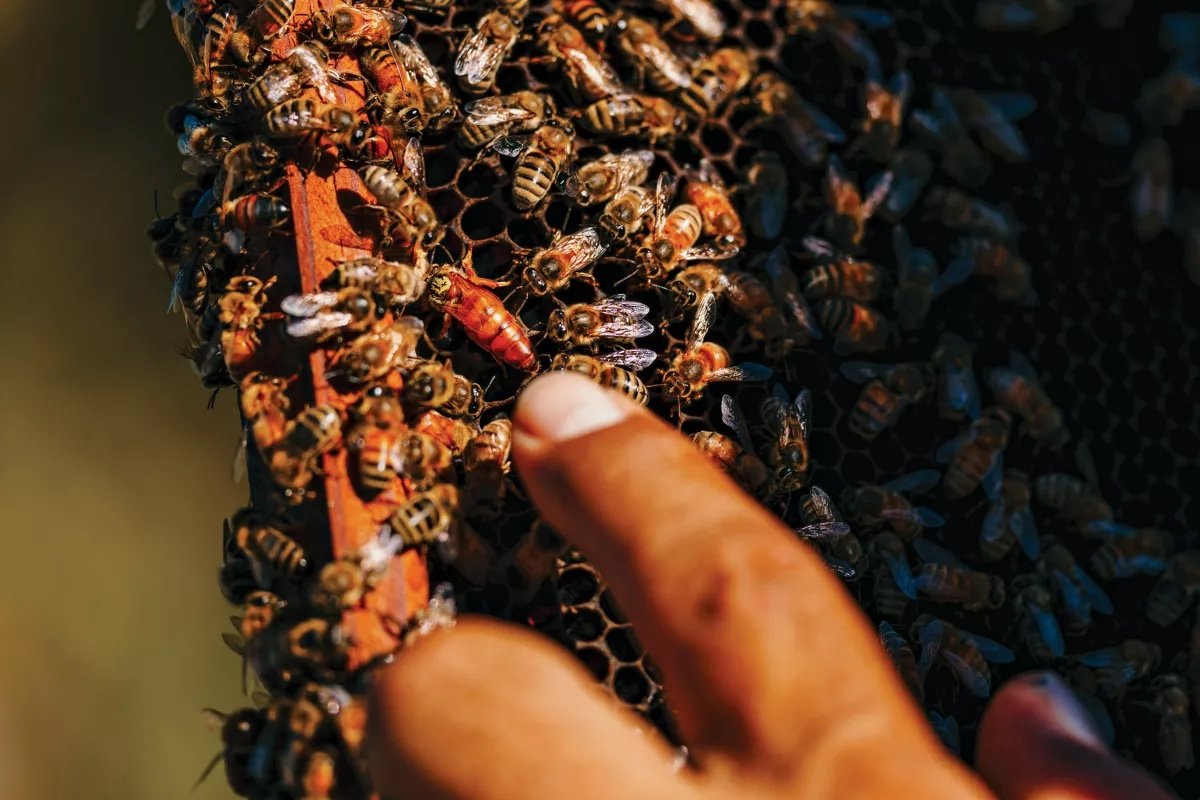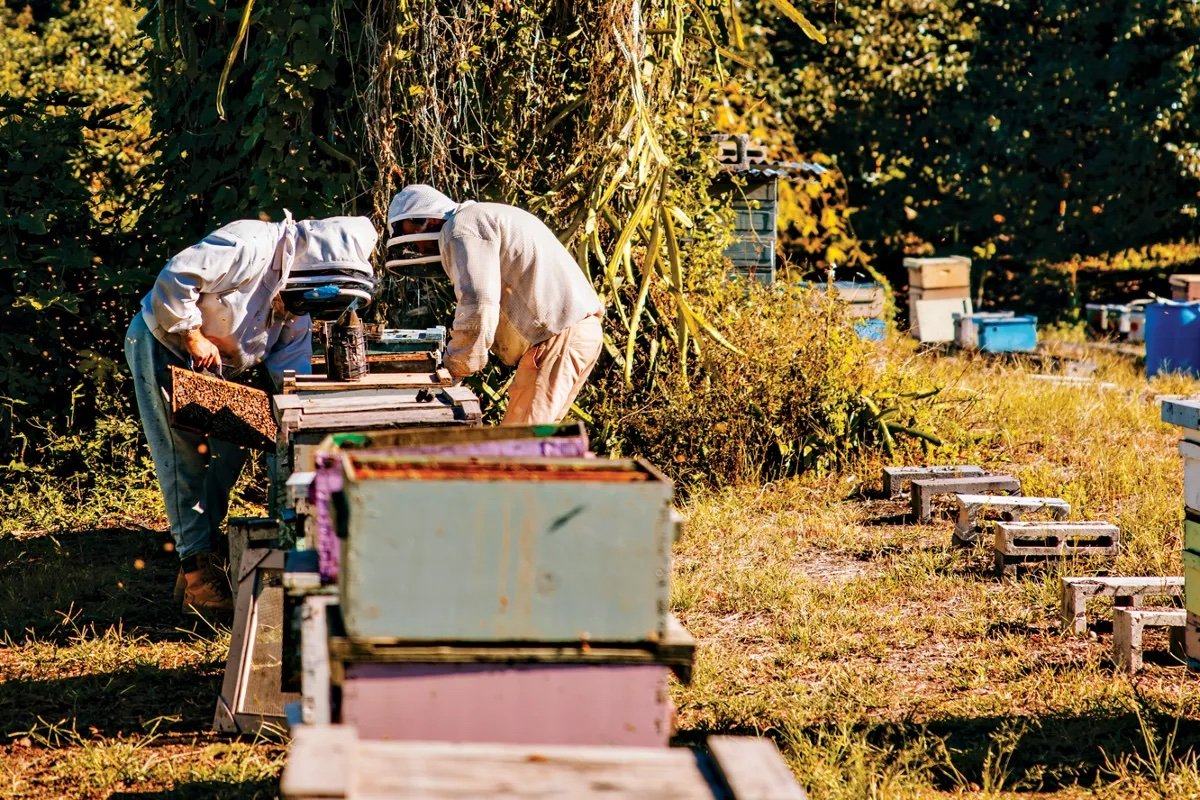AAA Explorer: Buzz Worthy
Beekeepers toil at the Hawaiian Queen Company in Captain Cook. The company ships its honeybee queens around the world. Photo by Andrew Richard Hara
Originally posted at aaa.com
By Christine Thomas | December 16, 2024
Black and about the size of a honeybee’s head, Hawaiian yellow-faced bees fly around naupaka shrubs in swirling patterns that, if seen at all, seem more like those of flying ants or gnats than bees.
“Even if you’re sitting under a tree with a population of them, you may not notice,” says Jason Graham, an entomologist who has been at the forefront of research into the native bees ever since seven of its 60 species were declared endangered in 2016.
Yet most Hawai‘i residents think of bees as the European honeybee, imported to the Islands more than 150 years ago. Unlike the diminutive native bees, which quietly pollinate our native plant ecosystem, honeybees have more visibly impacted Hawai‘i and fostered robust honey and queen-rearing industries.
Of course, all of Hawai‘i’s bees are important to the environment, agriculture, and business. It’s no wonder people around the state are engaged in learning about, raising, and helping our bees thrive.
Making a queen
A queen bee at Hawaiian Queen Company, which ships queens worldwide. Photo by Andrew Richard Hara
In rural areas mostly on Hawai‘i Island’s west side, breeders produce one of our state’s most important exports: queen honeybees. Hawai‘i is the world’s largest producer of early-season queen bees: Exported to the mainland and Canada, they help keep bee colonies healthy in order to grow the agriculture that North America and Hawai‘i depend on.
Rebeca Krones with her father, Michael Krones. Photo by Andrew Richard Hara
“We assist beekeepers with the process of pollination,” says Rebeca Krones, operations manager at family-owned Hawaiian Queen Company in Captain Cook, in business since 1997. It’s an important industry that may be largely unfamiliar to residents because it happens unseen against the backdrop of life. “We’re not a business-to-consumer industry, so it’s not as visible to people the way something like macadamia nuts or coffee is,” Krones says.
Because of our temperate climate, Hawai‘i breeders can start shipping queens in January as opposed to April, when mainland breeders begin offering queens. The Kroneses can’t produce enough queens to supply demand and sell out months in advance, the norm among Hawai‘i’s breeders. “There are not enough feral bees to pollinate orchards like there used to be,” says Krones. “Our queens pollinate most of the food products we eat.”
Working with bees at Hawaiian Queen Company. Photo by Andrew Richard Hara
As feral bee populations decline, more beekeepers also need queens to start new colonies. Unfortunately, colonies are often lost to pests like the varroa mite, which feeds off honeybees like a tick. Breeders must constantly defend—and find strategies to protect—hives from these invaders. Hawaiian Queen uses organic acids to treat hives for mites while also continually selecting for genetic traits such as gentleness, productivity, and hygienic behavior, keys to combatting mites naturally.
“We are supporting a keystone species,” says Krones. “Without honeybees, our food production would be greatly diminished. Queen breeding is a very important piece of that puzzle.”
Hiding in plain sight
A Hawaiian yellow-faced bee. Photo by Jason Graham
While threats to feral honeybee populations trigger concerns about diminished food production, the endangered Hylaeus, the Hawaiian yellow-faced bee, receives far less attention. “Most people I talk to don’t even know there were native bees in Hawai‘i,” says Graham.
From 2014 to 2018, he partnered with Hawai‘i’s Department of Land and Natural Resources and the United States Fish and Wildlife Service while conducting postdoctoral research at the University of Hawai‘i, Mānoa, that monitored yellow-faced bees in state-protected areas.
Factors from climate change to habitat loss threaten Hawai‘i’s native bees and, in turn, the plants with which they co-evolved, like naupaka. Illegal development in Kahuku recently erased 2 acres of coastal habitat—one of only four remaining habitats on O‘ahu—for Hylaeus anthracinus and H. longiceps.
Beach erosion and even everyday human actions can also impact survival by simply fragmenting habitats. “People enjoying the beach might make a walking trail through a naupaka stand,” says Graham. “This might separate a big population of bees into two smaller populations, as they prefer not to—or cannot—cross the trail.”
Graham’s research has likewise revealed the damage invasive ants cause in attacks on yellow-faced–bee nests, which usually are built in existing holes in trees or on the ground, where nests are vulnerable to invaders.
In 2016, Graham teamed up with Jim Boone, former entomology collection manager at Bishop Museum, to launch the ongoing Pollinators in Paradise project. The goal is to educate the public about Hawaiian yellow-faced bees and engage citizen scientists in reporting sightings to better understand where populations can be found.
“We already have so many people looking at honeybees and honeybee problems,” says Graham, “but we are still at the stage where we need more information to help the native bee population.”
Sweet reward
People have kept bees for thousands of years as a backyard honey source, to improve plant yield, or for a living. In 2006, Krones began buying honey byproduct from her family’s queen-breeding business and selling it under her former Royal Hawaiian Honey brand; she now sells it in bulk to U.S. honey brand Sue Bee.
Michael Domeier and Amy Grace of Rare Hawaiian Honey Company. Photo courtesy Rare Hawaiian Honey Company
Others start small and get hooked, like marine biologist Michael Domeier, who began beekeeping to encourage the passion fruit vines in his California orchard to bear fruit. “The biology of the bees fascinated me, and it wasn’t long before we had tons of beehives and then tons of passion fruit, and then honey we sold locally and online,” he says.
Domeier and his wife, Amy Grace, grew their backyard hives to 40, then in 2013 moved to Hawai‘i Island to helm what was at first an 80-hive-strong Rare Hawaiian Honey Company. Today they care for more than 600 hives.
“On a day-to-day basis we are constantly learning,” says Grace. “You’re constantly working with Mother Nature and being hands-on.”
That means adapting to everything from flowers that bloom unexpectedly to connecting their high-end, certified organic kiawe honey with the right customers. As part of that effort, they now distribute their honey to the West Coast via Whole Foods Markets and plan to move from Waimea to an expanded visitors center and farm store in Pu‘uanahulu.
As the only major commercial producer of honey made from the nectar of kiawe flowers, Domeier and Grace have a unique story to tell, and demand regularly outpaces production. “If it wasn’t for that, we’d be just another honey company,” jokes Domeier. “The average person doesn’t realize how much honey and how many queens are produced here.”
As residents learn more about our bees, Domeier and others think people are finding a warm space in their hearts for these powerful pollinators. If the first step is awareness and education, perhaps a hive or nest of one’s own is next. “What if we could get as many beekeepers caring for native bees as for honeybees?” says Graham. “Could we solve the problem of [declining] pollinators?”
Where to learn more about Hawai‘i’s bees
Island of Hawai‘i
Aloha ‘Āina Botanical Chef’s Garden and Bees Tour
On the Kohala Coast, guests at the AAA Four Diamond Fairmont Orchid can tour resort gardens and four beehives (home to more than 80,000 honeybees) that produce rare, mono-floral kiawe honey. Director of Hawaiian Culture Ka‘iulani Blankenfeld discusses tropical and culinary plants and pollinator plant legends. Free for hotel guests. 2 p.m. Tuesdays.
Big Island Bees
Honey tasting at Big Island Bees in Captain Cook. Photo by Jeremy Chien
From the bee museum to a behind-the-screen open-hive demonstration, tour guests at this Captain Cook business glimpse bee pupae and learn where the queen lives and what makes healthy hives. Tours conclude with mono-floral honey tastings. Reservations required. Closed Saturdays and Sundays. Kama‘āina adult admission, $25.
Rare Hawaiian Honey Company
Rare Hawaiian Honey Company. Photo courtesy Rare Hawaiian Honey Company
Taste rare and culinary blends at the honey tasting bar in the company’s new visitors center and farm store in Kailua–Kona. Ask about bee safari tours in the works. Closed Wednesdays, Fridays, Saturdays, and Sundays.
O‘ahu
Jasmine Joy’s Beelieve Hawaii offers courses in beekeeping. Photo by Gretchen Powers
Beelieve Hawaii
Get one-on-one holistic beekeeping instruction from Jasmine Joy of Beelieve Hawaii via virtual or in-person courses like her upcoming Intro to Ethical Beekeeping ($2,400 for 16 sessions). She also rescues and relocates feral bee colonies on O‘ahu and shares the plight of native Hawaiian yellow-faced bees with 1,000 schoolchildren every school year through her Pollinator Outreach Program.
Pollinators in Paradise
At a small exhibit at Bishop Museum’s Science Adventure Center in Honolulu, citizen scientists can learn about Hawaiian yellow-faced bees and how to post sightings via the iNaturalist app, through which more than 1,500 users contribute observations about 146 pollinator species in Hawai‘i. Kama‘āina adult admission, $19.95.
At home
Interested in starting your own hive or using more honey in the kitchen? The Hawai‘i Beekeepers’ Association is a good place to start.









